This story has my blood boiling and I just stopped everything I was doing to cover it.
I’d like to introduce you to Grace Schara.
From OurAmazingGrace:
Grace Naomi (Emily) Schara, 19, of Freedom passed into the loving arms of Jesus at St. Elizabeth’s Hospital on Wednesday, October 13, 2021.
Grace was born on September 22, 2002, to Scott and Cindy (Cournoyer) Schara. “The Lord gave us a ‘very precious gift’ in Grace and blessed us beyond what any person can imagine.” Her NICU nurses helped us choose the name Grace over Faith. It fit perfectly because it is by God’s Grace she was brought into this world. She lived up to her name and often told people she was “named after one of God’s principles”. Grace was Grace and she portrayed grace.
With Grace, the sky was the limit and she worked hard to accomplish all she did in the short time while here. Her extra 21st chromosome didn’t stop her, but instead gave her the ability to reach for the stars! Grace enjoyed horse riding from age 3 until present. She always had a love for music and ultimately found Elvis Presley a favorite. A trip to Graceland blessed her with meeting the ‘real Priscilla Presley’ something she loved to tell others about. Her dream job was to work at Graceland someday as a tour guide. She loved playing violin, especially Elvis’ songs, and even played one for her sister’s wedding. She also loved to dance and performed in many recitals bringing that extra flair and contagious smile. She loved being homeschooled and was a beautiful writer and artist, and had so many wonderful friends! She loved singing in the choir and acting in homeschool musicals. She enjoyed being a Girl Scout and going door to door selling 1000 boxes of cookies (earning a Super Seller Award), an American Girl Doll, and Camp Certificate each year.
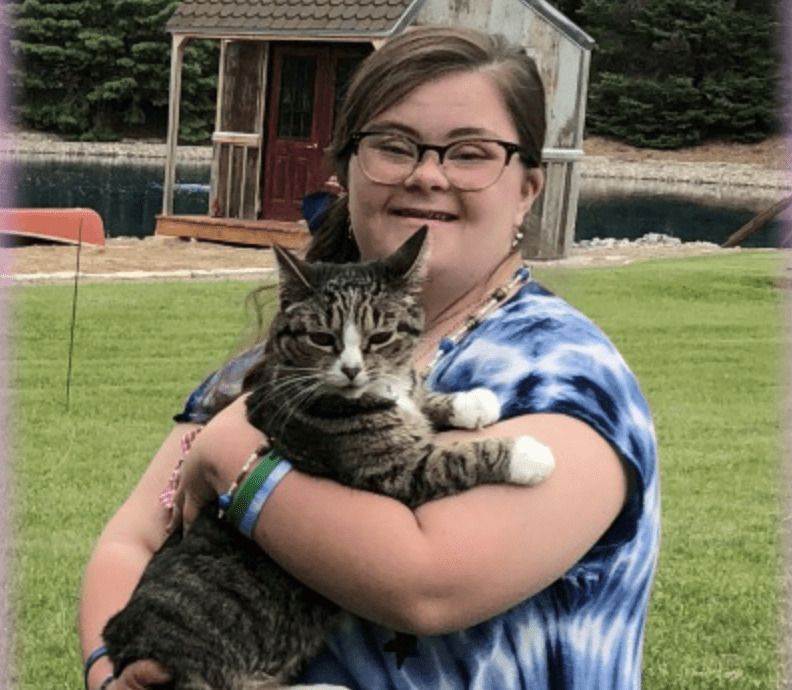
Grace was born with Down Syndrome, and was living a full and thriving life until she was recently admitted to St. Elizabeth’s for Covid-19 respiratory issues, according to multiple reports.
The family is questioning whether the hospital’s actions resulted in her death.
There are so many parts to this story that have my blood boiling, but we’ll get to those in a second.
Billboards are going up all over the FOX Valley area asking these questions:
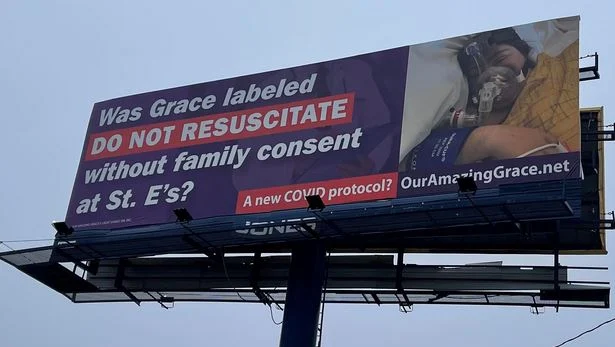

I can’t even imagine…
Now let’s get into some of the details.
According to the website OurAmazingGrace which is believed to be administered by the family, here is a quick summary of what happened:
Grace Schara, a beautiful 19 year old young girl with Down Syndrome, died on October 13 at a COVID hospital – a hospital following the government treatment protocols that continue to fail at preventing COVID deaths. Many hospitals are committed to following what the government dictates, and receive financial benefits by doing so. Grace’s case highlights many abuses, along with the dangers of financial temptation. This is a tragic story that can help wake us up to what’s happening in many hospitals today and turn us to the only One who can truly fix this mess.
By listening to, and reviewing, the links and documents on this website you’ll learn who Grace was, the care she received, the specific combination of medications used to kill her, the financial incentives COVID hospitals are offered, and the possible agenda behind this tragedy. Most importantly, we hope you know God is real and cares about each of us.
Scott Schara (Grace’s dad), and his daughter Jessica (Grace’s sister), were given a rare opportunity to witness what really happens inside the doors of a COVID hospital. The fear of COVID, being spread by the media, has the population convinced to be afraid of this virus. This fear causes people to not challenge the hospital policies preventing advocates, family members, and caregivers in the room with COVID patients. As this family studied what happened with Grace, they have become aware of thousands of similar cases where advocates attempted to push back, but the hospitals proceeded with their agendas instead. It is hard to believe this is really happening here, in America.
This family’s conclusions are this: Once the hospital realized they would not convince the family to give the hospital authority to put Grace on an unnecessary ventilator at the doctor’s discretion, it’s probable that Grace was worth more dead than alive; perhaps there were patients, who would better facilitate their goal of profitability, waiting in ER for a COVID bed to open. On the final day of Grace’s life, after the doctor proclaimed how well Grace was doing, he unilaterally labeled Grace as DNR and then a combination of IV sedatives and narcotics were administered over a short timeframe that no one would survive, especially if already in respiratory distress. After reviewing the details, you be the judge.
Before going public, the family submitted a detailed summary, with supporting research, to the hospital with a request to meet with the CEO and the doctor involved. The family recognized their ethical and Biblical responsibility to give both of them the opportunity to discuss their perspectives. The hospital response was a refusal to meet.
The family has not taken the FEMA funeral reimbursement money available to them ($9,000). Cindy Schara (Grace’s mom) says, “We don’t want their dirty money.” Taking the money would be an acknowledgement that Grace died of COVID. As you will learn, she did not die of COVID!
If true, this is truly the worst of the worst and calling for “accountability” and justice doesn’t even begin to describe what needs to happen here.
From UndercoverDC:
What Happened? Hospital Neglect Leading to Grace’s Last Day
On Sept. 28, Grace began receiving appropriate doses of Ivermectin when facing COVID-19 symptoms. On Oct. 1, with symptoms persisting, Grace’s parents gave her a home COVID test. She tested positive, but they were prepared. Already following recommendations from America’s Frontline Doctors and FLCCC, the Schara’s had on hand the necessary essentialsto work through COVID. Still, according to Scott, a few days later, “[Grace] couldn’t maintain her oxygen above 90, so we ended up taking her to urgent care, which led to the emergency room. And the emergency room physician recommended that we admit her to the hospital.”
The Emergency Department at Ascension’s St. Elizabeth Hospital wanted to admit Grace. However, the hospital informed Scott that due to “hospital protocol not allowing anyone in the room,” he could not come with her. Scott told the hospital that he would take Grace home if he could not go to the room with her. After “a meeting of the minds,” he was told he could stay with his daughter as long as he didn’t leave the room. Scott was fine with that, as he was not planning to leave the room anyway. So, Grace was admitted to the hospital. Further explaining how important it was he stay with Grace, Scott added:
“One of the things Grace was unable to do in this situation is to speak up or stand up for herself in terms of treatment and things like that. That’s a natural part of what she was dealing with. And so, I did what any dad should do. I stood by my daughter and tried to protect her.”
Grace’s first full day in St. Elizabeth’s was Oct. 7. Scott described the day as “very normal”—they watched movies and “horsed around.” Scott explained that later in the day, Grace was frustrated and fighting back a little with the “high-flow cannula [that was] shooting air up her nostrils at 40 miles an hour or so.” Clearly, Grace did not like the uncomfortable aspect of that treatment. On the morning of the second day, Oct. 8, Scott had the first real sense of “there’s something going on here” when a doctor came into the room and told him:
“In the next two hours, we’re going to have to put your daughter on a ventilator.”
Immediately, Scott wanted to know the reasoning behind such a drastic decision. The directive turned out to be based on blood gas numbers from the previous night when Grace was aggravated with the cannula and “wrestling with a BiPAP mask.” The situation had caused a blood pressure reading of 235/135 and a heart rate of 150 beats per minute. Knowing her elevated numbers were provoked by the situation the night before, Scott asked the hospital to retake them. They did, and just as he predicted, Grace was fine. Scott added:
“So we dodged the first ventilator bullet at that point.”
The next day, Saturday, Oct. 9, Scott said Grace felt back to normal. She was hungry after not eating much the day before, and they ordered food off the menu. Once it arrived, Scott began feeding Grace. Swiftly, a nurse entered the room and told him that he could not feed Grace due to her 85% oxygen saturation. Not buying the 85% number, Scott (who had much of his COVID protocol with him after being told by the hospital that “he would get COVID-19 while there”) retested Grace with his own oxygen saturation meter -it read 95%. He asked the nurse if his meter reading was correct, and she said it was. Thoroughly discouraged, Scott explained:
“The hospital’s meter read 85%, so I put mine on, and it read 95%. I called the nurse back in, and I said, “is my oxygen meter accurate?” She said, “yes.” I said, “well, why does yours only read 85% and mine reads 95%?”
[The nurse] admitted my meter was accurate and said hers was inaccurate. I asked why, and she said, “well, the leads get sweaty.” I said, “if you know that, why don’t you proactively change them out every four hours or whatever it needs to be?” She [sarcastically] said to me, “you should be thankful you caught this.”
So process this reality. The primary statistic they’re using to manage my daughter’s care, including recommendations for all kinds of crazy things, including a ventilator, is the oxygen sat[uration]. Their oxygen saturation numbers are wrong, and they’re recommending a ventilator based on that.
More:
Grace’s Last Day: The Alarmingly Cruel Facts
In the four days leading up to her death, Grace was given the Pfizer drug Precedex, a short-term sedative (to be used for 24 hours or less, according to the package insert). On Oct. 13, the day of Grace’s death, nurse Hollee McInnis—under orders from Dr. Gavin Shokar—started “ratcheting up” the administration of Precedex. By 10:48 am, Grace (who was placed in restraints around 9 am that day for wanting to go to the bathroom) was receiving 14 times the initial dose.
Then, at 11:25 am on the day of her death, the hospital gave Grace a dose of the Pfizerdrug Lorazepam. Next, at 5:46 and 5:49 pm—three minutes apart—they gave her two more doses of Lorazepam. Following that, at 6:15 pm, they gave Grace a two-milligram dose of Morphine—also manufactured by Pfizer—as an IV push, not a drip.
As shown below, in a bold warning, Pfizer’s prescribing information for Morphine highlights the severe and life-threatening risk of “profound sedation, respiratory distress, coma, and death” when combined with benzodiazepines (in this case, Lorazepam) and CNS (central nervous system) depressants (in this case, Precedex). Additionally, the insert clearly states, “Have Naloxone Injection and resuscitative equipment immediately available.” As emphasized by a heartbroken Scott, the hospital did not have the reversal drug Naloxone at Grace’s bedside ready to go if needed.
More:
At 6:45 pm, thirty minutes after the doctor administered the two-milligram dose of Morphine, he called Scott and his wife to tell them, “Grace had a good day.” He also informed them he had just given Grace Morphine. Stunned, Scott asked the doctor why Grace was given Morphine and was told, “because she was breathing at 51 breaths a minute.” In disbelief, a devastated Scott detailed to attorney Tom Renz the final 42 minutes of Grace’s life, explaining:
“Think it through—they caused the breathing to go like this. Of course, I didn’t know anything about this combination of drugs at that time. Jessica then called us at 7:20 pm while she was in the room with Grace. She has us on FaceTime. My wife and I are watching and can see Grace, and [we can also see] Jessica panicking because Grace’s numbers are tanking. And we’re hollering, “get the nurses in the room.”
Jessica said, “I’ve already done that, they won’t come in.” So we’re all hollering at these nurses. She estimated there were about 30 nurses outside the door at that time because of the shift change, and they would not come into the room. We were hollering, “Save our daughter, help her.” And they hollered back, “She’s DNR [do not resuscitate].” We screamed, “She’s not DNR.” My wife questioned, “Are you not helping our little girl because she has Down Syndrome?”
This was the first we knew that Grace was DNR. The doctor had put the order in the computer, but we did not sign the DNR. We never asked for a DNR. At approximately 7:22 pm, one of the nurses read the DNR note to Jessica from the computer screen, [implying we couldn’t] do anything about it. But the DNR law, which I’ve looked up, requires them to override a DNR if the patient or a power of attorney requests it. Well, of course we requested it—this is our daughter. They stood outside the room, and it got even worse. They had an armed guard outside the room. So we watched her die on FaceTime.”
The family has posed the question: “Was Grace Killed Because She Had Down Syndrome?”
Note, that’s not me asking that question…that’s the family direclty.
From their website OurAmazingGrace:
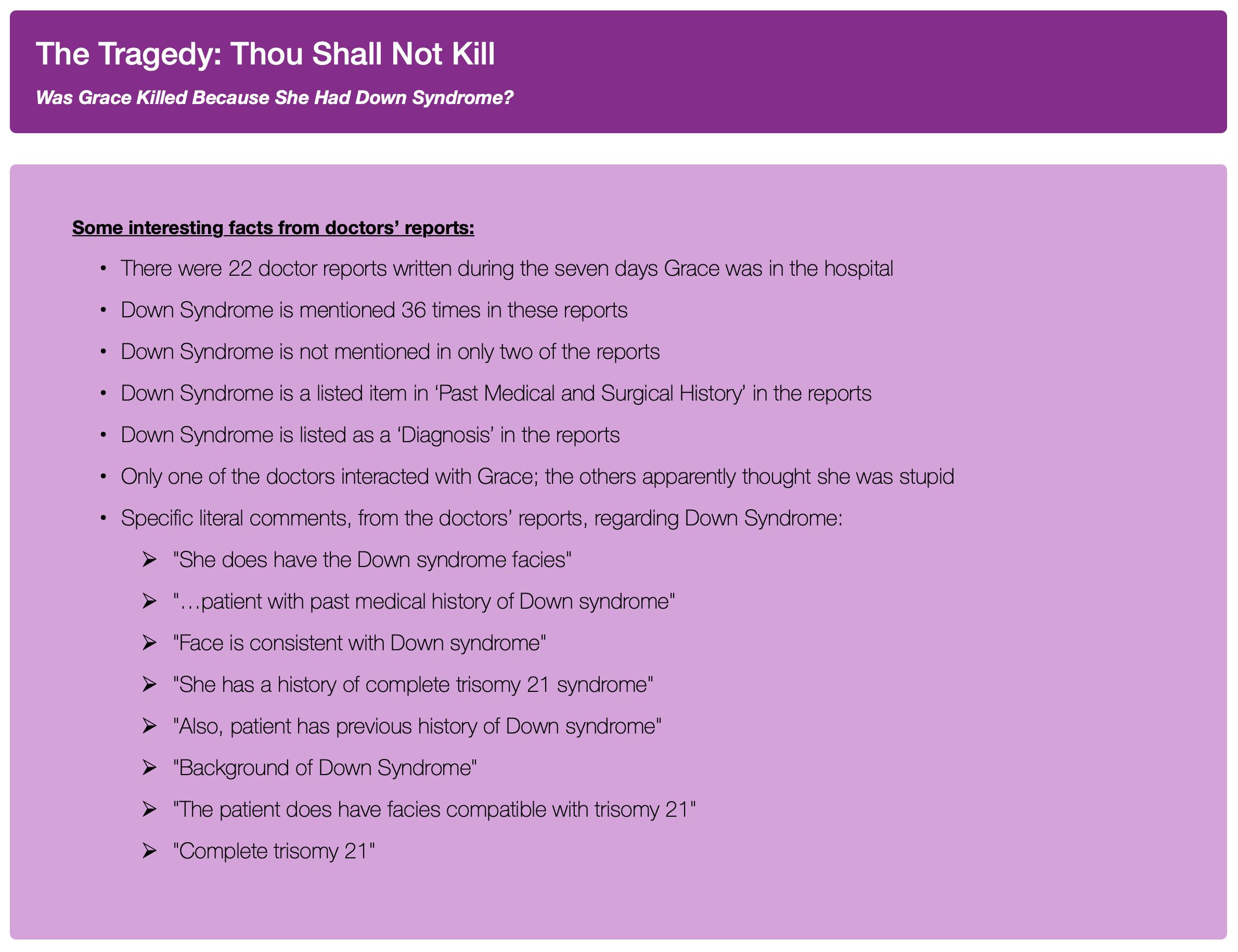
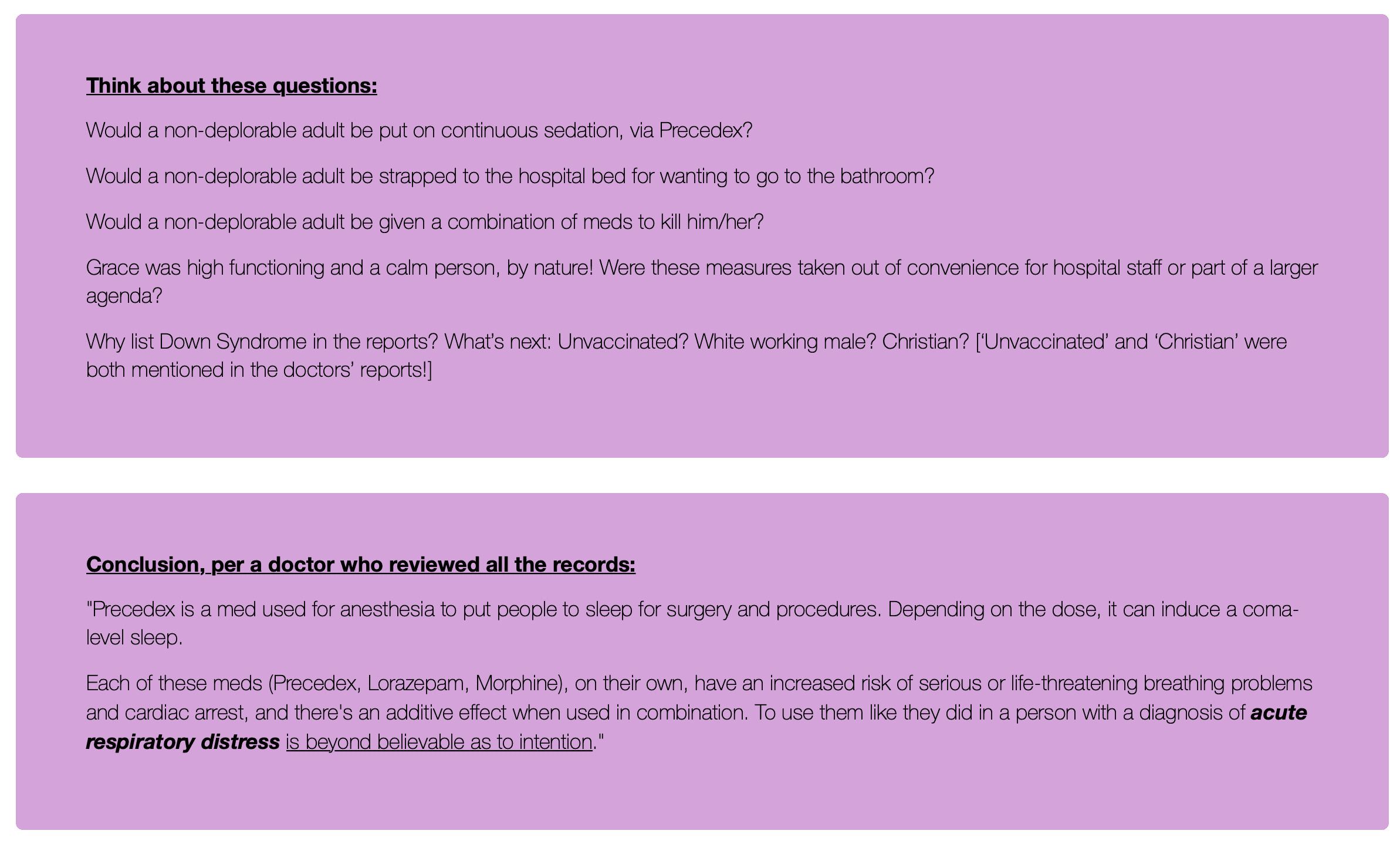
I am still shaking as I type this article…
Justice must be done!
Please help us get this word out everywhere.
Truth and justice must prevail.
I’ll end by saying this…we don’t know everything that happened in that hospital. We weren’t there. We are simply reporting on what the family is claiming. But if what the family is claiming is true, it is damning to the worse degree possible.
So I’ll just leave it to you…what do you think?
👇

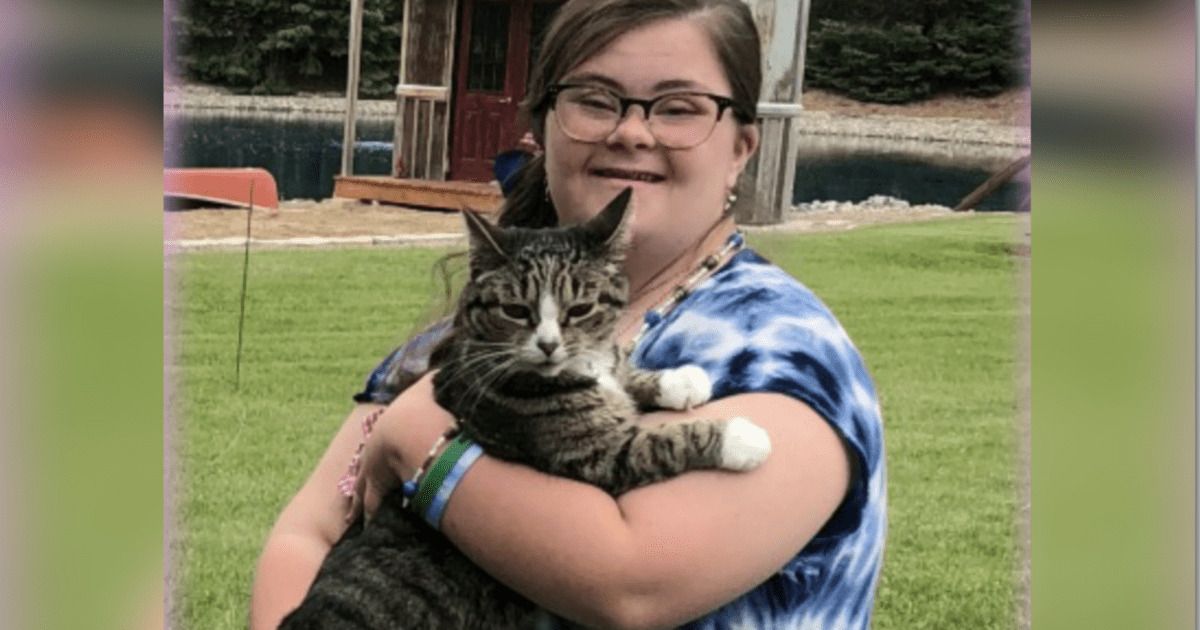

Join the conversation!
Please share your thoughts about this article below. We value your opinions, and would love to see you add to the discussion!